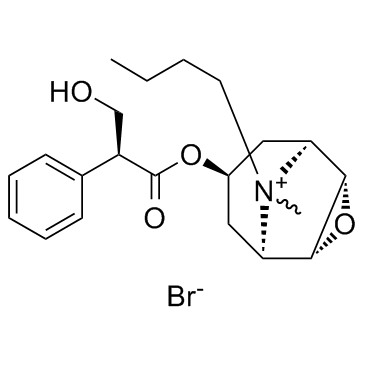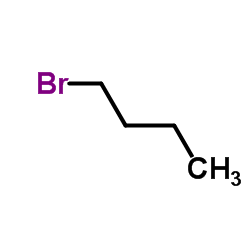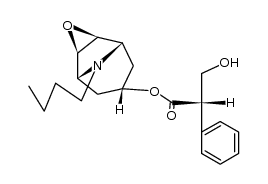149-64-4
| Name | N-Butylscopolammonium Bromide |
|---|---|
| Synonyms |
(1R,2R,4S,5S,7s,9S)-9-Butyl-7-{[(2S)-3-hydroxy-2-phenylpropanoyl]oxy}-9-methyl-3-oxa-9-azoniatricyclo[3.3.1.0]nonane bromide
(−)-N-Butylscopolamine bromide (−)-Scopolamine N-butyl bromide Hyoscine N-butyl bromide EINECS 205-744-1 MFCD00078561 3-Oxa-9-azoniatricyclo[3.3.1.0]nonane, 9-butyl-7-[(2S)-3-hydroxy-1-oxo-2-phenylpropoxy]-9-methyl-, bromide, (1R,2R,4S,5S)- (1:1) Scopolamine butylbromide Hyoscine butylbromide Hyoscinen buty1bromide |
| Description | Scopolamine butylbromide is a competitive antagonist of muscarinic acetylcholine receptor (mAChR) with an IC50 of 55.3 ± 4.3 nM.Target: mAChRScopolamine (USAN), also known as levo-duboisine and hyoscine, sold as Scopoderm, is a tropane alkaloid drug with muscarinic antagonist effects. It is among the secondary metabolites of plants from Solanaceae (nightshade) family of plants, such as henbane, jimson weed (Datura), angel's trumpets (Brugmansia), and corkwood (Duboisia). Scopolamine exerts its effects by acting as a competitive antagonist at muscarinic acetylcholine receptors, specifically M1 receptors; it is thus classified as an anticholinergic, antimuscarinic drug. Its use in medicine is relatively limited, with its chief uses being in the treatment of motion sickness and postoperative nausea and vomiting. Scopolamine is named after the plant genus Scopolia. The name "hyoscine" is from the scientific name for henbane, Hyoscyamus niger. |
|---|---|
| Related Catalog | |
| References |
| Melting Point | 142-1440C |
|---|---|
| Molecular Formula | C21H30BrNO4 |
| Molecular Weight | 440.371 |
| Exact Mass | 439.135803 |
| PSA | 59.06000 |
| Water Solubility | H2O: 50 mg/mL |
CHEMICAL IDENTIFICATION
HEALTH HAZARD DATAACUTE TOXICITY DATA
|
| Symbol |

GHS07 |
|---|---|
| Signal Word | Warning |
| Hazard Statements | H302 |
| Precautionary Statements | P301 + P312 + P330 |
| Personal Protective Equipment | dust mask type N95 (US);Eyeshields;Gloves |
| Hazard Codes | Xn: Harmful; |
| Risk Phrases | R22 |
| RIDADR | NONH for all modes of transport |
| WGK Germany | 3 |
| RTECS | YM3500000 |
| Packaging Group | III |
| Hazard Class | 6.1 |
| HS Code | 2939999090 |
|
~% 
149-64-4 |
| Literature: GB708370 , ; DE856890 , ; |
|
~% 
149-64-4 |
| Literature: Arzneimittel-Forschung/Drug Research, , vol. 35, # 1 A p. 217 - 228 |
| Precursor 3 | |
|---|---|
| DownStream 0 | |
| HS Code | 2934999090 |
|---|---|
| Summary | 2934999090. other heterocyclic compounds. VAT:17.0%. Tax rebate rate:13.0%. . MFN tariff:6.5%. General tariff:20.0% |




